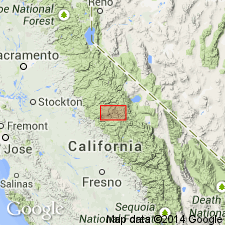
- Usage in publication:
-
- Cathedral Peak granite*
- Modifications:
-
- Named
- Dominant lithology:
-
- Granite
- AAPG geologic province:
-
- Sierra Nevada province
Summary:
[Named for fact it composes Cathedral Peak and adjoining parts of Cathedral Range in Yosemite National Park, CA]. [no type locality designated] Is 2nd youngest unit of Tuolumne intrusive series. Composed of coarsely porphyritic rock in which biotite is more abundant than hornblende. Contains unusually large phenocrysts of feldspar. Intrudes Half Dome quartz monzonite and is intruded by Johnson granite porphyry both units of Tuolumne intrusive series. [Is probably Cretaceous age].
Source: GNU records (USGS DDS-6; Menlo GNULEX).
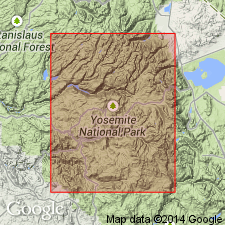
- Usage in publication:
-
- Cathedral Peak granite*
- Modifications:
-
- Geochronologic dating
- AAPG geologic province:
-
- Sierra Nevada province
Summary:
K-Ar age of 83.7 Ma was obtained on biotite of Cathedral Peak granite.
Source: GNU records (USGS DDS-6; Menlo GNULEX).
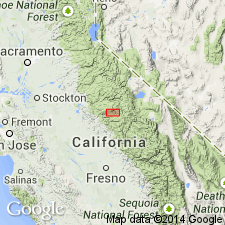
- Usage in publication:
-
- Cathedral Peak Granite*
- Modifications:
-
- Age modified
- AAPG geologic province:
-
- Sierra Nevada province
Summary:
Not exposed in Yosemite Valley but boulders of this unit in moraines of valley are among evidences of glaciation of Sierra Nevada. Age changed from probably Cretaceous(?) to Cretaceous based on K-Ar age of 83.7 Ma [Evernden and others, 1957].
Source: GNU records (USGS DDS-6; Menlo GNULEX).
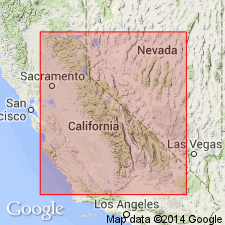
- Usage in publication:
-
- Cathedral Peak Quartz Monsonite*
- Modifications:
-
- Redescribed
- Dominant lithology:
-
- Quartz monzonite
- AAPG geologic province:
-
- Sierra Nevada province
Summary:
Unit redescribed as Cathedral Peak quartz monzonite in study of Thompson Canyon bedrock.
Source: GNU records (USGS DDS-6; Menlo GNULEX).
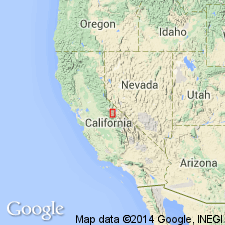
- Usage in publication:
-
- Cathedral Peak Granodiorite*
- Modifications:
-
- Redescribed
- Age modified
- AAPG geologic province:
-
- Sierra Nevada province
Summary:
Named changed to Cathedral Peak Granodiorite because composition is predominantly granodiorite. Is early Late Cretaceous age (Evernden and Kistler, 1970, p.17).
Source: GNU records (USGS DDS-6; Menlo GNULEX).
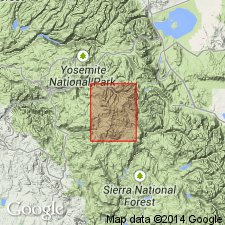
- Usage in publication:
-
- Cathedral Peak Granodiorite*
- Modifications:
-
- Revised
- AAPG geologic province:
-
- Sierra Nevada province
Summary:
Name Tuolumne Intrusive Series changed to Tuolumne Intrusive Suite. Map explanation shows units of suite (older to younger): granodiorite of Grayling Lake, granodiorite of Kuna Crest, granite of Marie Lakes, Half Dome Granodiorite, Cathedral Peak Granodiorite, and [Johnson Granite Porphyry]. The S end of Cathedral Peak Granodiorite centered on Tuolumne Meadows is exposed along north edge of Merced Peak quad NE of Merced Lake. Assigned Late Cretaceous age.
Source: GNU records (USGS DDS-6; Menlo GNULEX).
For more information, please contact Nancy Stamm, Geologic Names Committee Secretary.
Asterisk (*) indicates published by U.S. Geological Survey authors.
"No current usage" (†) implies that a name has been abandoned or has fallen into disuse. Former usage and, if known, replacement name given in parentheses ( ).
Slash (/) indicates name conflicts with nomenclatural guidelines (CSN, 1933; ACSN, 1961, 1970; NACSN, 1983, 2005, 2021). May be explained within brackets ([ ]).

